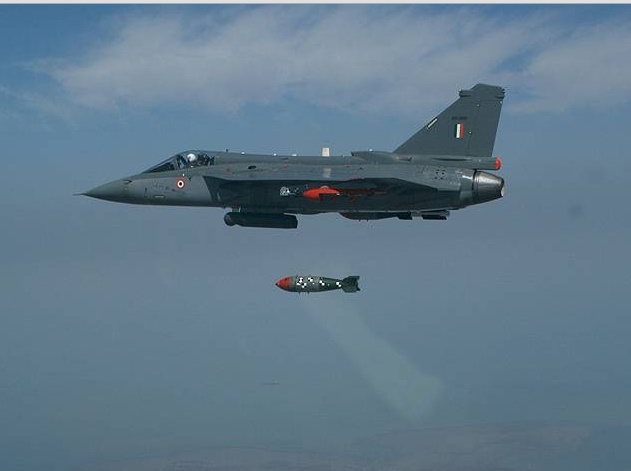|
|
||
* It was in 1984
that the government of India first moved decisively to kick-start the process
to build an indigenous aircraft. Aeronautical Development Agency (ADA) was
set up by the government to develop the programme.
|
||
* In 1986, Rs 575
crores were allocated by the then government towards funding the programme.
|
||
* On January 4th,
2001, the light combat aircraft made its first flight, a milestone in the
Indian aviation industry. Then Prime Minister Atal Behari Vajpayee named the
aircraft ‘Tejas’ – which means ‘radiance’ in Sanskrit.
|
||
* The induction
of Tejas comes at an important time when the IAF has wanted to desperately
replace it with the ageing fleet of MiG-21, responsible for so many crashes.
|
||
* The aircraft is
equipped to handle air-to-air missiles, air-to-surface missiles, anti-ship
missiles, bombs and rockets.
|
||
* The aircraft’s
structure is composed of 42% carbon fibre composites, 43% aluminium alloy and
the remainder titanium alloy.
|
||
* The aircraft is
being developed in single-seat fighter and twin-seat trainer variants for the
IAF and the Navy.
|
||
* Earlier this
year, the aircraft participated in its first foreign show at the Bahrain
International Air Show 2016 where aircraft enthusiasts compared it to
Pakistan’s JF-17 Thunder, that was produced with the help of China.
|
||
* It is
considered to be the lightest multi-role supersonic aircraft of its class.
|
||
* The aircraft
can travel at a maximum speed of 2,205 km/hr for FOC version and 2,000 km/hr
for IOC version.
|
||
Weapons
|
||
The aircraft has
eight external hardpoints to carry stores, with three under each wing, one on
the centre fuselage and one installed under the air intake on the port side.
|
||
A 23mm
twin-barrelled GSh-23 gun with a burst firing rate of 50 rounds a second and
muzzle velocity of 715m a second is installed in a blister fairing under the
starboard air intake.
|
||
The aircraft can
be armed with air-to-air, air-to-ground and anti-ship missiles,
precision-guided munitions, rockets and bombs. Electronic warfare, targeting,
surveillance, reconnaissance or training pods can be carried on the
hardpoints. Drop tanks can also be carried.
|
||
In October 2007,
the aircraft successfully test-fired the R-73 air-to-air missile.
|
||
The Vympel R-73
(Nato codename AA-11 Archer) missile is an all-aspect short-range missile
with cooled infrared homing. It can intercept targets at altitudes between
0.02km and 20km, g-load to 12g and with target speeds of up to 2,500km/h.
|
||
The Indian
Government will purchase Derby beyond-visual-range air-to-air missiles
(BVR-AAM) from Rafael Advanced Defence Systems to incorporate on 200
aircraft..
|
||
These missiles
are expected to be delivered by the end of 2012. They will supersede Astra
BVR-AAM and accelerate the development process. The weapon tests on Tejas
were carried out at the Pokhran range in September 2011.
|
||
The aircraft's
electronic warfare suite, developed by the Advanced Systems Integration and
Evaluation Organisation (ASIEO) of Bangalore, includes a radar warning
receiver and jammer, laser warner, missile approach warner and chaff and
flare dispenser.
|
||
Armament
|
||
Guns: 1× mounted
23 mm twin-barrel GSh-23 cannon with 220 rounds of ammunition
|
||
Hardpoints: 8 (1×
beneath the port-side intake trunk for targeting pods, 6× wing, and 1×
fuselage) with a capacity of 3,500 kg external fuel and ordnance and
provisions to carry combinations of:
|
||
Rockets: S-8
rocket pods, Bofors 135 mm rocket
|
||
Missiles:
|
||
Air-to-air
missiles:
|
||
Astra
|
||
Derby
|
||
Python-5
|
||
R-77
|
||
R-73 (missile)
|
||
Air-to-surface
missiles:
|
||
DRDO
Anti-Radiation Missile
|
||
Kh-59ME
(TV-guided standoff missile)
|
||
Kh-59MK
(Laser-guided standoff missile)
|
||
Anti-ship
missiles
|
||
Kh-35
|
||
Kh-31
|
||
Bombs:
|
||
KAB-1500L
laser-guided bombs
|
||
GBU-16 Paveway II
|
||
FAB-250
|
||
ODAB-500PM
fuel-air explosives
|
||
ZAB-250/350
incendiary bombs
|
||
BetAB-500Shp
powered concrete-piercing bombs
|
||
FAB-500T gravity
bombs
|
||
OFAB-250-270
gravity bombs
|
||
OFAB-100-120
gravity bombs
|
||
RBK-500 cluster
bomb stake
|
||
Other:
|
||
Drop tanks for
ferry flight/extended range/loitering time
|
||
LITENING
targeting pod
|
||
Avionics
|
||
Hybrid version of
Israel’s Elta EL/M-2032 multi-mode fire control radar
|
||
Sensors and radar
|
||
Electronics
Research and Development Establishment and HAL have jointly developed the
aircraft's multimode radar. The radar has multiple target search and
track-while-scan and ground-mapping modes of operation. It includes pulse
Doppler radar with Doppler beam shaping, moving target indication and look-up
/ look-down capability. The radar is mounted in a Kevlar radome
|
||
Comparision between
Pakistan’s Chinese JF-17 .vs Indian Tejas
|
||
Plane
|
JF-17
|
LCA
|
Length
|
14m
|
13.2m
|
Wingspan
|
9.45m
|
8.20m
|
Height
|
4.77m
|
4.40m
|
Wing Area
|
24.4m2
|
38.4m2
|
Empty Weight
|
6,411 kg
|
6560 kg
|
Loaded Weight
|
9,100kg
|
10,500 kg
|
Max. Take off Weight
|
12,700 kg
|
13,300 kg
|
Powerplant
|
1 × Klimov RD-93
or WS-13 turbofan
|
1 × General
Electric F404-GE-IN20 turbofan
|
Dry Thrust
|
49.4Kn
|
53.9Kn
|
Thrust with Afterburner
|
84.4Kn
|
85Kn
|
G-limit
|
+8.5 g
|
9 to (neg)3.5 g
|
Internal Fuel Capacity
|
2300 kg
|
2458 kg
|
External fuel capacity:
|
3 external fuel
drop tanks (1× under-fuselage 800 litres, 2× under-wing 800/1100 litres each)
for extended range/loitering time
|
2x1200 litre drop
tank at inboard, 1x725 litre drop tank under fuselage.
|
Crew
|
1
|
1
|
Maximum speed
|
Mach 1.8
|
Mach 1.8
|
Ferry range
|
3,480 km
|
3,000 km
|
Service ceiling
|
16,920 m
|
15,250 m
|
Thrust/weight
|
0.95
|
1.07
|



